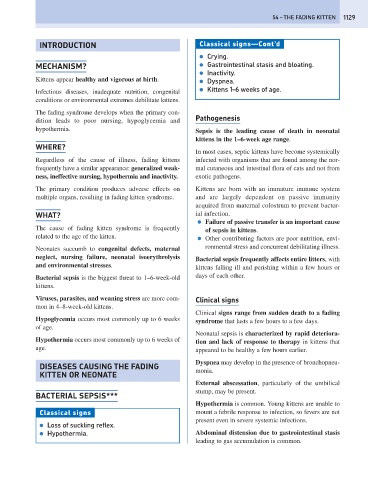Page 1137 - Problem-Based Feline Medicine
P. 1137
54 – THE FADING KITTEN 1129
INTRODUCTION Classical signs—Cont’d
● Crying.
MECHANISM? ● Gastrointestinal stasis and bloating.
● Inactivity.
Kittens appear healthy and vigorous at birth. ● Dyspnea.
● Kittens 1–6 weeks of age.
Infectious diseases, inadequate nutrition, congenital
conditions or environmental extremes debilitate kittens.
The fading syndrome develops when the primary con-
Pathogenesis
dition leads to poor nursing, hypoglycemia and
hypothermia. Sepsis is the leading cause of death in neonatal
kittens in the 1–6-week age range.
WHERE?
In most cases, septic kittens have become systemically
Regardless of the cause of illness, fading kittens infected with organisms that are found among the nor-
frequently have a similar appearance: generalized weak- mal cutaneous and intestinal flora of cats and not from
ness, ineffective nursing, hypothermia and inactivity. exotic pathogens.
The primary condition produces adverse effects on Kittens are born with an immature immune system
multiple organs, resulting in fading kitten syndrome. and are largely dependent on passive immunity
acquired from maternal colostrum to prevent bacter-
WHAT? ial infection.
● Failure of passive transfer is an important cause
The cause of fading kitten syndrome is frequently of sepsis in kittens.
related to the age of the kitten. ● Other contributing factors are poor nutrition, envi-
Neonates succumb to congenital defects, maternal ronmental stress and concurrent debilitating illness.
neglect, nursing failure, neonatal isoerythrolysis Bacterial sepsis frequently affects entire litters, with
and environmental stresses. kittens falling ill and perishing within a few hours or
Bacterial sepsis is the biggest threat to 1–6-week-old days of each other.
kittens.
Viruses, parasites, and weaning stress are more com- Clinical signs
mon in 4–8-week-old kittens.
Clinical signs range from sudden death to a fading
Hypoglycemia occurs most commonly up to 6 weeks syndrome that lasts a few hours to a few days.
of age.
Neonatal sepsis is characterized by rapid deteriora-
Hypothermia occurs most commonly up to 6 weeks of tion and lack of response to therapy in kittens that
age. appeared to be healthy a few hours earlier.
Dyspnea may develop in the presence of bronchopneu-
DISEASES CAUSING THE FADING monia.
KITTEN OR NEONATE
External abscessation, particularly of the umbilical
stump, may be present.
BACTERIAL SEPSIS***
Hypothermia is common. Young kittens are unable to
Classical signs mount a febrile response to infection, so fevers are not
present even in severe systemic infections.
● Loss of suckling reflex.
● Hypothermia. Abdominal distension due to gastrointestinal stasis
leading to gas accumulation is common.

